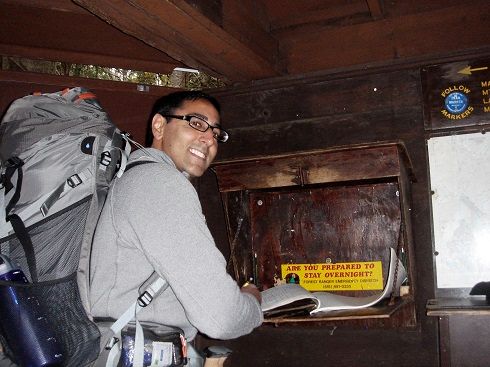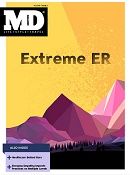Publication
Article
MD Magazine®
Extreme ER
Author(s):
A wilderness medicine physician fuses medicine with improvisation as he provides urgent care in extreme locations.

There is virtually no wilderness in Nassau County, Long Island—a densely populated suburban region better known for traffic jams than hazards of nature.
So why would Sanjey Gupta, MD, director of emergency medicine at Franklin Hospital in Valley Stream, invest his time and money in training as a specialist in wilderness medicine?
It’s complicated.
There is a direct need for expertise in the new specialty, Gupta said in a recent interview.
He was able to draw on it when a patient who jumped off the Whitestone Bridge—a span over the East River linking Queens and the Bronx—was brought to his emergency room.
The patient survived his suicide attempt but needed trauma care and was hypothermic.
Gupta knew it was crucial to get every piece of wet clothing off of him, and that his body temperature was likely to plunge even though the team was working hard to get him warm.
“Once you start warming someone the cold blood in the arms and legs get shunted into the core and your body temperature drops again,” he said. That was disconcerting to the trauma team.
“They got very upset because they didn’t understand what was going on,” he said. But due to his wilderness training Gupta was able to explain the phenomenon, known as “after-drop,” was to be expected. The patient just needed more aggressive warming measures.
Gupta, an outdoor enthusiast who does events that include off-road biking, running, and orienteering as well as “ultra” marathons, expects to be able to use his training in his own recreational pursuits. He is also an educator who has done 100 hours of course work and is a Fellow in the Academy of Wilderness Medicine (FAWM), a nonprofit group that sets professional standards in the field. To become a fellow means taking course in 12 areas, including medical training for emergencies related to diving, tropical illnesses, mountaineering, sports, disasters, and traumatic injuries.
Several entities, both for-profit and nonprofit, offer courses.
Those include Wilderness Medicine, a for-profit continuing medical education company in Bozeman, MT. It was founded 25 years ago “to provide education on wilderness, travel, and expedition medicine with topics not generally taught in medical school or residency training,” a company spokesman said.
Many participants combine their own love of adventure travel with their need to get CME credits. Training events are held in Hawaii, at the base camp of Mount Everest, in the Galapagos Islands, in Alaska, and a range of other locales known for scenic beauty and challenging environments.
Among the colleagues Gupta has met through his pursuit of wilderness medicine is Liz Edelstein, MD, FAWM, who joined him in teaching a course in the specialty for Cornell medical school students.
She is now practicing both emergency medicine and wilderness medicine in San Diego, CA and is director of Jefferson Wilderness Medicine in Philadelphia. Until moving to San Diego she was faculty director of the Mid-Atlantic Student Wilderness Medicine Conference.
“I’ve always loved the outdoors,” Edelstein said, “and I realized I could join my passion with my profession and settled into the niche of wilderness medicine, focusing mainly on education.”
The specifics of the medical training are mostly advanced first aid, and the need to drill recreational enthusiasts on the importance of being prepared.
They cover topics like educating back country hikers, skiers, and campers to always think about the possibility of an emergency. That means taking something to make a fire, a basic medical kit, a foil blanket or heavy-duty plastic trash bag for warmth or shelter, a lightweight splinting device, and other common sense instructions.

Course topics include managing venomous bites, nasty cuts, fractures, reaching and extricating patients in whitewater, and ideas for improvising medical equipment. “1001 Uses for Duct tape and Safety Pins” is one course the Wilderness Medicine offers this summer.
And even though wilderness medicine emphasizes performing without technology, there is one exception, Gupta said.
“The cell phone is the greatest wilderness tool there is,” he said, either to call for help or to enable rescuers to track a position.
But wilderness medicine also engenders a more subtle transformation, Gupta said
“We go back to practicing medicine the way we did before we had CT scans and lab tests,” he said, “We really talk to the patient,” and have to rely on that communication and a physical exam “in an environment where our technology has been stripped away.”
He said it has made him a better physician in general.
“You never know when you’ll be needed but this training gives you the confidence to handle anything,” he said.
Meanwhile, there is a growing need for the specific skills used.
Physicians are needed at “extreme” recreational events. People are pushing themselves harder, physically and mentally, and at ages that once were considered elderly. Marathons have almost gotten passé as a physical challenge.
“People are doing 100-mile races, or multi-day races several hundred miles long,” he said. There are races in the Jordanian desert, and in the Sahara. “People are looking to see what the limits of physiology are.” Gupta said.
Commercial events like Tough Mudder runs, military-style obstacle courses, are getting more popular. Despite the occasional death or serious injury among participants in these 10-to-12-mile circuits, relentless marketing by the company has drawn over 1.3 million participants since 2010 (70% are men, average age 29.) The company has also launched a series of “mini-mudders” 1-mile obstacle course events for children.
These companies need physicians and other medically trained workers to consult on safety and to be at the events to help with broken bones, near drownings, and other mishaps, he said.
Another place the wilderness training comes into play is for those physicians who volunteer to go into places struck by natural disasters or epidemics like Ebola.
“If you go into a low-resourced environment you need to be able to take care of yourself, and not become part of the problem,“ Gupta said.
“A lot of well-meaning people with this knowledge become burdens,” he said. “If you can’t sterilize water or set up simple sanitation or bring food for yourself you become a burden despite having good intentions,” Gupta said, and there have been cases where doctors trying to help in areas struck by catastrophes ended up being evacuated themselves.
There is no true table of organization to the field of wilderness medicine, Gupta said. Several specialty societies like the American College of Emergency Physicians have sections on the discipline. The Wilderness Medical Society is one of several educational entities that offer CME courses. Some of these organizations are university-affiliated, some are nonprofit, others like Wilderness Medicine, are for-profit.
Anyone who is involved in the medical field can learn wilderness medicine, and not just physicians, he said.
When it comes to deciding which CME course to take, Gupta advised choosing ones that are approved by the Accreditation Council for Continuing Medical Education.
But while skills and training are useful, Gupta said the main effect of training is the impact it has on a physician’s basic sense of competence.
“You and your patient have to focus on communication skills and that interaction will enrich you as a physician no matter what your specialty,” he said.
Videos: in a recent interview with MD Magazine, Gupta discusses his field and his adventures. See parts 1 and 2 below.






